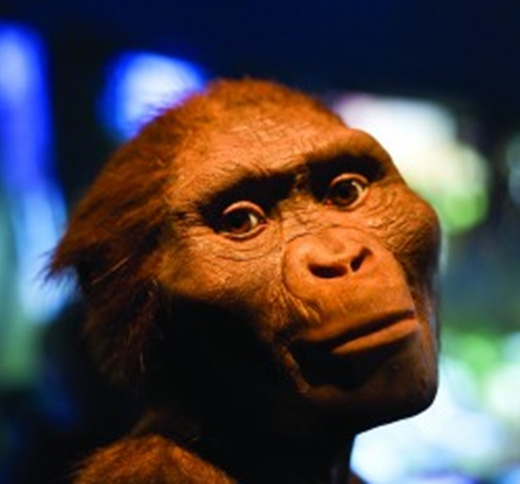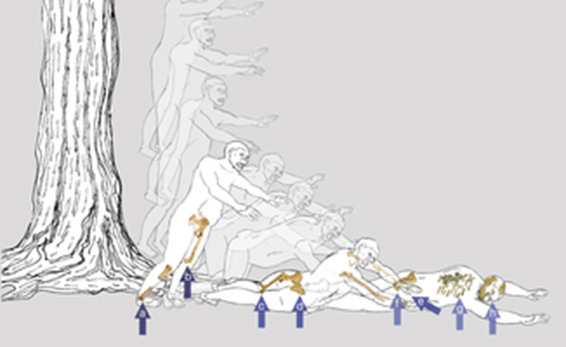
Credit: HMNS.
When did our ancestors leave the trees and begin to lead a life on solid ground? Some real life CSI has given us a big clue.
Lucy—the 3-million-year-old skeleton of one of our oldest known human relatives—was recently on a museum tour of the United States.
During her visit, University of Texas scientists examined her skeleton with geological CT scanners, similar to medical CAT scans but with higher resolution.
Fossil bones often break as they’re buried, but Lucy’s upper arm showed something unusual. It was compressed, with sharp fracture lines and tiny bone fragments intact.
The team called in an orthopedic surgeon, who confirmed that this injury in modern humans only occurs when they extend their arms to try to break a fall from considerable height.
So they began to look for other fracture evidence of a fall—and found it, in her ankle, knee, pelvis, and ribs.
They then looked to modern chimpanzees, which are about the same size as Lucy. Chimps nest in trees at heights of up to 35 ft, high enough that a fall could result in the same type and degree of fracturing found in Lucy.
Further studies using the CT data showed that her ratio of arm strength to leg strength was more like chimps than humans.
Both findings suggest that 3 million years ago, our ancestors may have lived a significant part of their lives in the trees.
Background
Synopsis: When famous 3.18-million-year-old Australopithecus afarensis specimen Lucy was examined by scientists, an orthopedic surgeon confirmed her fractures are consistent with a fatal fall of at least 40 ft, providing evidence that this species, our human ancestor, must have spent time in the trees.
- In 1974, while working in the Afar region of Ethiopia, Arizona State University anthropologist Donald Johanson and graduate student Tom Gray discovered Lucy, a 3- million-year-old fossil hominin different from any other of that age: she walked erect on two feet like a human. Forty percent of her skeleton was recovered, which is remarkable for the skeleton of an individual. Ever since then, scientists have debated whether she spent time in trees or lived exclusively on the forest floor.
- Lucy’s skeleton was stored in a vault in Ethiopia for decades after the discovery, but she finally went on a museum tour of the United States in 2008. Before the tour, she came to The University of Texas at Austin (UT), where Drs. John Kappelman and Rich Ketcham teamed up to use the High-Resolution X-ray Computed Tomography Facility (UTCT) at the UT Jackson School of Geosciences to completely scan the remains of her skeleton. This industrial-strength scanner, having higher resolution than medical CAT scanning, can see through materials as dense as rock while leaving the irreplaceable fossil unharmed.
- The researchers noticed that Lucy’s skeleton had a number of unusual fractures. Fossil bones usually break and dislocate as they are buried, but the head of Lucy’s humerus at her right shoulder was compressed and showed sharp breaks, with tiny bone fragments intact. In humans, this type of fracture only occurs when a person tries to break a long fall by extending his or her arms. Lucy must have been alive when these breaks occurred!
- What they found caused them to add Austin orthopedic surgeon Dr. Stephen Pearce to the team. He confirmed that the injury was “consistent with a four-part proximal humerus fracture, caused by a fall from considerable height when the conscious victim stretched out an arm in an attempt to break the fall.” Additional fractures of the right ankle, left knee, pelvis, and first rib all suggested severe trauma, similar to what might occur from a collision at about 35–40 mph. There was no evidence of healing, so Lucy must have died from her injuries.

- But how did Lucy get these injuries in the first place? She was small, only about 3’6” and 60 lb. The researchers looked to modern chimpanzees of about the same size, which nest in trees at heights of up to 35 ft to stay safe from predators in the forest. A fall from that height by a creature of that size would result in a maximum velocity of about 35–40 mph.
- Lucy’s injury pattern enabled the scientists to reconstruct her fatal fall: feet first, then twisting to the right in an attempt to break her fall, and then finally falling forward. At that speed, she would have suffered severe internal organ failures, leading to her death.
- This unusual multidisciplinary forensic study provides evidence that this human ancestor, the Pliocene Australopithecus afarensis, did move through the trees at least some of the time.
- Recent studies using the UTCT data also show that Lucy had amazing arm strength, more similar to chimpanzees than to humans, providing yet more evidence that she spent significant amounts of time in the treetops.

